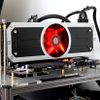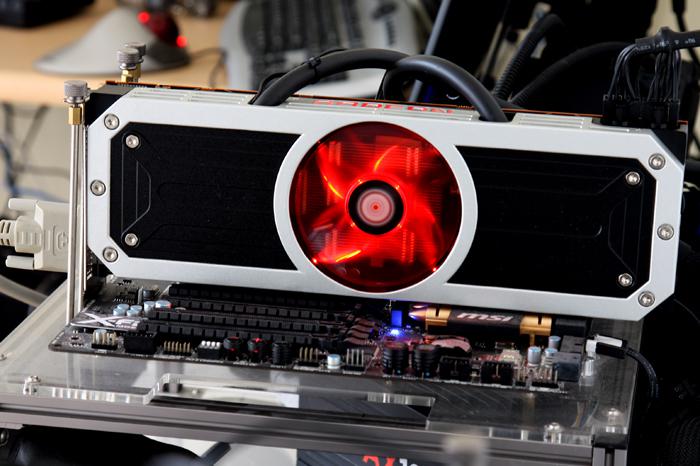AMD Islands & Technology
Specs & Sea Islands
So over the past two years you have been hearing about several codenames and that can be a little confusing. It's simple really, in the market we have entry level, mainstream and high-end products. When you notice "Cape Verde" that's entry level, such as the current 7700 series. Pitcairn would be the codename the mainstream products like the 7800 hides under, and Tahiti is the codename for the GPUs used on AMD's most high-end graphics cards. The current (enthusiast level) generation GPUs are the Volcanic Islands
- Enthusiast level Hawaii Pro/XT = Radeon R9-290 and 290X
- Vesuvius is the dual Hawaii XT = Radeon R9 295x2
Technology
For the series, Hawaii series in general, the GPU architecture was overhauled back in 2013. AMD is still on a 28nm process technology, the Hawaii GPU based cards are all PCIe gen 3 compatible and there have been significant changes on power consumption. With the launch of the Radeon R9 290/290X/295x2 Eyefinity was updated towards version 2.0 with full support for DDM audio (you hear audio on the actual monitor it's played of). And you may now create custom multi-monitor resolutions. TrueSound has been included, as well as Mantle for a selection of games. More on that later though. But allow me to throw some specs at you, 12 Billion transistors, 5632 Stream processors, 11.5 TFlops and 8 GB of memory. Impressive, eh? AMD bakes GPU's on the 28nm node, in very simple wording that means they can put more transistors on a smaller silicon die area. The Hawaii core has 6 Billion transistors. So make no mistake -- the same silicon Hawaii XT is being used though for the X2 edition, the Hawaii XT GPUS are packed with 2816 activated shader processors per GPU
R9 290X (Hawaii XT)
- Stream Processors 2816
- Clock Frequency up-to 1 GHz
- 5.6 TFLOPS compute performance
- 4 GB memory at 5.0 Gbps / 512-bit
- 250W TDP
- PCI-E 3.0
- API - DirectX 11.2 / OpenGL 4.3 / Mantle
- Stream Processors 5632
- Clock Frequency up-to 1.02 GHz
- 11.5 TFLOPS compute performance
- 8 GB memory at 5.0 Gbps / 512-bit
- 500W TDP
- PCI-E 3.0
- API - DirectX 11.2 / OpenGL 4.3 / Mantle
When you break things down you will have noticed that each of the GPUs used have a whopping 6.2 Billion transistors all fitted on a 438 mm2 Die size. At 28 nm AMD applied the GCN (2.0) architecture. With revision 2.0 there have been a few tweaks at cache levels as the L2 cache is now 1MB for example. More on that later though.
| AMD Radeon Card | HD 7970 GHz | HD 7990 | R9 290X | R9 295x2 |
| Process | 28nm | 28nm | 28nm | 28nm |
| Transistors | 4.3 Billion | 8.6 Billion | 6.2 Billion | 12.4 Billion |
| Engine Clock | 1.05 GHz | 1 GHz | > 1 .00 GHz | > 1 .02 GHz |
| Stream Processors | 2,048 | 4,096 | 2,816 | 5,632 |
| Compute Performance | 4.3 TFLOPS | 8.2 TFLOPS | 5.6 TFLOPS | 11.5 TFLOPS |
| Texture Units | 128 | 256 | 176 | 352 |
| Texture Fillrate | 118.4 GT/s | 256 GT/s | 176 GT/s | 358 GT/s |
| ROPs | 32 | 64 | 64 | 128 |
| Pixel Fillrate | 29.6 GP/s | 64 GP/s | up-to 64 GP/s | up-to 130 GP/s |
| Z/Stencil | 128 | 256 | 256 | 512 |
| Memory Bit-Interface | 384-bit | 384-bit | 512-bit | 512-bit |
| Memory Type | 3 GB GDDR5 | 3 GB GDDR5 x2 | 4 GB GDDR5 | 4 GB GDDR5 x2 |
| Data Rate | 6.0 Gbps | 6.0 Gbps | 5.0 Gbps | 5.0 Gbps |
| Memory Bandwidth | 288 GB/s | 288 GB/s | 320.0 GB/s | 320.0 GB/s x2 |
With the Hawaii GPUs came an interesting step from AMD is the move towards a 512-bit memory bus. Nobody really expected it as in the past AMD merely once used it on one of their products. That was the ATI Radeon HD 2900 XT all the way back in 2007, the one with the ring-bus design. They went back to 256 and 384-bit busses because the 512-bit bus simply was complex and using a lot of wires/traces on the PCB. It kind of does make sense right now to make the move towards 512-bit. The GDDR5 being used is cheaper then newer memory formats, and the cheaper 5.0 Gbps in fact saves on overall costs to adapt towards 4 GB graphics memory. AMD makes use of eight 64-bit memory controllers accumulating towards 512-bit. Combined with the graphics memory clocking in at 5.0 Gbps this will bring a 320 GB/sec memory bandwidth towards the graphics card.
PowerTune
AMD has a fully implemented "Turbo" feature much like NVIDIA's boost technology on all of their products. This means that there is no longer a fixed clock on these cards. The GPU clock will get a baseline and maximum frequency, the card will clock up/down in-between these two values based on power draw/limiters, performance and heat. In return the card will adaptive manage fan control, clock frequency and voltages (dynamic). AMD always has been much more reserved with the difference in between baseline and maximum frequency, so the difference in values won't be extremely big. Eyefinity has also received a small update. You can now mix and match any monitor (similar monitors) output and create an Eyefinity setup. So if you have three of the same monitors you could hook up one to HDMI, one to DVI and one to DP.


